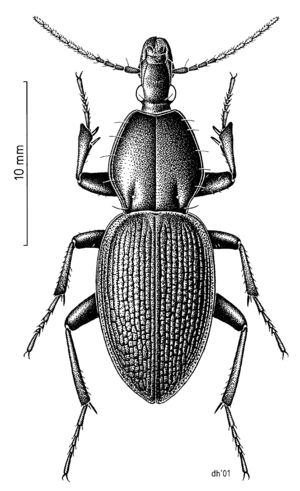Maoripamborus facts for kids
Quick facts for kids Maoripamborus fairburni |
|
|---|---|
 |
|
| Illustration by Des Helmore | |
| Scientific classification | |
| Kingdom: | |
| Phylum: | |
| Class: | |
| Order: | |
| Suborder: | |
| Family: | |
| Genus: |
Maoripamborus
Brookes, 1944
|
| Species: |
M. fairburni
|
| Binomial name | |
| Maoripamborus fairburni Brookes, 1944
|
|
The Maoripamborus fairburni is a special kind of beetle. It belongs to a group called Carabidae, also known as ground beetles. This beetle is the only known species in its genus, Maoripamborus.
This unique beetle lives only in a specific part of the world. It is found in the northern North Island of New Zealand. Being "endemic" means it naturally lives nowhere else. The Maoripamborus fairburni is closely related to another beetle group called Pamborus, which lives in Australia.
Contents
What is a Ground Beetle?
Ground beetles are a very large family of insects. There are over 40,000 different species around the world. Most ground beetles are dark and shiny. They often have grooves on their wing covers. These beetles are usually found on the ground, under rocks, or in logs. They are known for being fast runners.
Where do they live?
Ground beetles live in many different places. You can find them in forests, fields, and even gardens. They like places where they can hide. Many species prefer damp environments. They are important parts of their ecosystems.
What do they eat?
Most ground beetles are predators. This means they hunt and eat other small creatures. They often feed on insects like caterpillars and slugs. Some ground beetles also eat seeds or plants. The Maoripamborus fairburni's exact diet is not widely known. However, it likely follows the habits of other ground beetles.
Life Cycle of a Beetle
Like all insects, beetles go through different life stages. This process is called metamorphosis. It includes four main stages.
Reproduction
Adult beetles mate to produce eggs. The female beetle lays her eggs in a safe place. This might be in the soil or under bark.
Larva Stage
After hatching, the eggs turn into larvae. Larvae are like small worms or grubs. They spend their time eating and growing. They shed their skin several times as they get bigger.
Pupa Stage
Once the larva is fully grown, it becomes a pupa. The pupa stage is a resting period. During this time, the beetle changes its body. It transforms from a larva into an adult.
Adult Stage
Finally, the adult beetle emerges from the pupa. The adult beetle is ready to mate. Then, the life cycle starts all over again.
Why is Maoripamborus fairburni Special?
The Maoripamborus fairburni is special because it is so rare. It is the only known species in its genus. This makes it a unique part of New Zealand's wildlife. Scientists are still learning about this beetle. They want to understand its habits and how to protect it.
Conservation Efforts
Protecting unique species like this beetle is important. It helps keep the natural world healthy. Scientists study where these beetles live. They also look at what they need to survive. This helps make sure they can thrive for many years.
See also
 In Spanish: Maoripamborus para niños
In Spanish: Maoripamborus para niños

